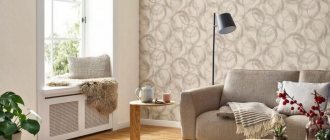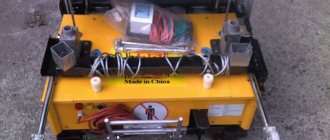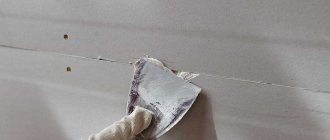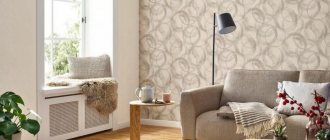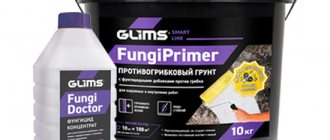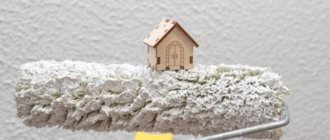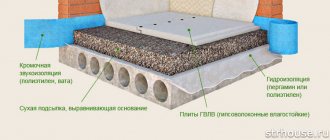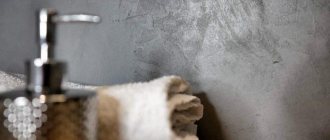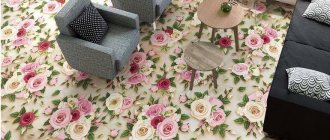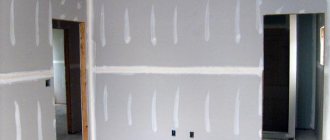How to glue meter-long wallpaper
The most popular are meter-long wallpaper, the sticker of which can be carried out by one person, and whitewash with color can be applied on top of it.
An obligatory step when gluing wallpaper is the process of removing air using a roller
In order for gluing to proceed correctly, you should follow several rules and recommendations:
- The wall is covered with glue, which is prepared in advance.
- The first sheet of wallpaper is adjusted in height, but there should be a hem on top, which will be cut off after drying. The lower part of the canvas is also folded and removed.
- Next, smoothing of the wallpaper is required to remove air accumulations using a wallpaper roller or rubber spatula.
- While smoothing is taking place and the canvas dries a little, you can cut off the unnecessary part using a stationery knife.
- If the cutting line begins to jiggle, then you should postpone this moment until later and continue gluing.
- If, when probing the canvas, voids are found, then you need to disconnect the sheet from the wall to this place, coat the wall with glue and repeat the entire process described above.
How important is wall preparation?
The procedure for wallpapering.
Washable wallpaper - one of the subtypes of vinyl - has a significant drawback. Their thinness requires careful preparation of the walls, filling in depressions, cracks, and irregularities, otherwise all the smallest flaws will be visible behind the wallpaper: grains of plaster sand, brush hairs, nail heads. Preparing the walls is an important stage of work. Sometimes it turns out to be more labor-intensive than wallpapering itself. Whatever you plan to cover the walls with, they must be flawless - freed from old wallpaper, peeling paint, whitewash, leveled, puttied, sanded and primed.
But foam vinyl wallpaper allows for roughness on the walls. The relief pattern on their surface makes them thick and creates some inconvenience when gluing. They need to be smoothed with a rubber roller so as not to damage the volumetric coating. Due to their thickness, small irregularities in the wall are invisible. The mottled wallpaper pattern also masks wall imperfections. If the wall itself has become mottled after puttying, then dark spots will appear through the thin, light, plain wallpaper. You are unlikely to be satisfied with such work. So, if you were lazy at the preparation stage, it is better to hang wallpaper in dark colors.
At what temperature can you glue wallpaper?
There are many opinions regarding the temperature at which wallpaper can be properly glued without causing defects. Any repairman will tell you that you need to cover concrete walls if you follow certain recommendations, and then the weather outside the window will not affect the final result.
If you plan to glue wallpaper in winter, then you need to carefully close all windows to avoid drafts
Recommendations:
- Regardless of where wallpapering takes place in an apartment or house, the temperature level should be at least 10 and no more than 25 ° C. This temperature is enough for the canvas to dry and stick tightly.
- The humidity level in the room should not be more than 60%. If the humidity is higher, the glue will begin to become saturated with it and the properties of the composition will be significantly reduced.
- When gluing wallpaper above a radiator or opposite a window, when direct ultraviolet rays hit the wall, you should be as careful as possible. It is advisable to turn off the batteries until the room is completely dry, and curtain the window, as otherwise the glue will dry too quickly and the wallpaper will become crusty, which will ruin the proper appearance of the room.
- The room must absolutely not be opened until the pasted canvases have dried. Any draft can cause repeated finishing work.
What is non-woven wallpaper
Non-woven (from the German word “Vliseline”, which means non-woven material) trellises are a rolled fabric made of cellulose fibers (about 70%) and additives. These are thin trellises with increased tensile strength. Despite their small thickness, they are embossed, creating a beautiful, original texture. They do not deform when the house shrinks. Easy to glue. They hide small imperfections on the wall surface well.
Non-woven fabric in its purest form.
According to numerous reviews on the forums, buyers are mostly satisfied with them. True, there are several sharply negative characteristics, but this is due to the fact that buyers were too lazy to find out in more detail what type of wallpaper they actually bought: non-woven or vinyl with a non-woven backing.
As a result, we bought glue for lightweight non-woven trellises, which fell off after a few days. This once again confirms the above statement that it is necessary to distinguish between non-woven wallpaper and vinyl wallpaper on a non-woven basis.
How to glue wallpaper with a pattern: recommendation
Pasting simple wallpaper is easy, but with a pattern it’s not easy for non-professionals. It is far from easy for someone without work experience to adjust a picture, especially alone. It is worth noting that when using printed material, you must immediately prepare for the fact that more costs will be required and there will be scraps left over.
The step between repeating a pattern can be very different, and, as a rule, you can familiarize yourself with it on the label of the canvas.
To decorate a living room or bedroom, you will need to purchase 3 more rolls than expected per square meter. You should not think that if the gluing is carried out behind cabinets and sofas without selection, then so much material will not be required, since the essence will remain the same.
It should be borne in mind that when hanging wallpaper with a pattern, there will be more scraps left than when hanging wallpaper without a pattern.
In addition, you need to select a design on three rolls at once, which will reduce both time and excessive costs and leftovers. When purchasing, you should pay attention to the batch, since different numbers can cause a lot of problems during repairs. There may be a difference in shade or even in the width of the pattern.
Before gluing the canvas, it needs to be cut off with an allowance, which will then allow you to cut the upper and lower borders clearly according to the level. Naturally, it is better to adjust the print on the floor and on dry canvases, which is much more convenient and hassle-free. Professional technology for high-quality pasting of canvases begins with a drawn mark along a vertical wall. In this way, too much error can be avoided. In addition, it is extremely inconvenient to pull a wet canvas along the walls in order to achieve a normal slope.
It’s not uncommon in apartments to have uneven walls, which can sometimes be visually hidden with wallpaper, but sometimes not. In this case, if you want to make high-quality repairs, you must first take care of leveling the surface. This can be done using a material such as rotband, but this is with minimal protrusions. For larger problems, you can use plywood, OSB, chipboard, MDF, and PVC plastic panels. With their help, it is much easier and quicker to finish the room.
PVC panels are considered a practical material, but do not tolerate mechanical stress, since their surface is very fragile.
Types of fabrics used
Various materials can be used as a base layer and additional coating. In this regard, novice craftsmen think about which wallpaper is easier for non-professionals to glue.
It’s worth noting right away that there is not much difference, but there are only some nuances that should be taken into account when fixing one or another type of wallpaper.
- Paper webs are the most economical type of product. Individual coating strips may consist of one or more layers. The sheets are fastened using a universal adhesive.
- Non-woven wallpaper is an improved analogue of the above products. They are stronger than paper, which reduces the risk of damage to segments during work. Special glue is required for fixation.
- Fiberglass analogues are a roll covering created using weaving technology from glass fibers of various thicknesses and densities. They are glued to the surface with a special compound for heavy materials.
An example of a fiberglass-based coating.
Addition! If a vinyl coating is applied to the base, then the canvases are considered moisture resistant, which means they can be washed. As for the textile layer, it can improve the decorative qualities of the finish.
Which wallpaper is easier for non-professionals to hang?
Experts believe that repair work should be carried out by professionals, but if you still want to do the repairs yourself, and do not have any special skills, then it is much better to choose those materials that are easier to handle. It is not advisable for pregnant women to work with wallpaper, as this can cause premature birth. Increased air temperature and physical labor are not desirable for such representatives of the fair sex.
To hang wallpaper end to end, you need to take measurements using a tape measure.
Non-professionals should not use additional materials such as:
- Newspapers;
- Baguettes;
- Tiles.
Moreover, there is no need to try to write patterns on wide whitewashed wallpaper yourself, as it may not look as expected. A room covered with wallpaper with a single pattern and one color is not at all boring if you choose the right shade, as well as textiles and furniture to match it. Beginners believe that it is easier to work with narrow wallpaper, but meter-long non-woven fabrics are in no way inferior to them. If the repair is carried out by two people, then preference should be given to wide wallpaper.
Since they are more:
- High quality;
- Sustainable;
- Durable;
- Durable.
The peculiarity of wide wallpaper is that its texture allows you to hide the unevenness of the walls and the joints themselves. Accordingly, it is possible to create a not really beautiful view of the living room and will create the impression of integrity and elegance. However, meter-wide wallpaper is not so easy to apply to a small room. For example, a kitchen or a corridor. Considering how many curves there are, sometimes there is a desire to completely cover the walls with decorative plaster and simply paint it later in the desired color, which can also be accessible to beginners. Working with the material is not difficult and does not require special skills, provided that the plaster is of the highest quality.
Low-quality materials will begin to crumble even during installation, which will significantly spoil the final result.
Which color hides imperfections better?
It's the wallpaper that hides imperfections, not the paint color. Lighting the room can solve the problem; the darker the room, the less problems on surfaces are visible. It is better to take a paint of a darker color and not glossy; I painted it with dark brown paint (matte), the irregularities are less noticeable.
Interesting materials:
How much do oil workers earn in Kazakhstan 2022? How much do officers earn in the army? How much do officers earn in Russia? How much do waiters earn in Korea? How much do university teachers earn? How much do dentists earn in Kyiv? How much do they earn in New Zealand? How much do doctors earn in America? How much has Messi earned throughout his career? How long can a roast be kept in the refrigerator?
Wallpaper gluing technology
The technique for gluing wallpaper is generally the same, since the canvas is applied exclusively vertically and not horizontally, with the exception of ceiling decoration, which is quite rare. Before work, you need to cut the canvases and fold them with the back side facing up. This will make it easier to apply the adhesive. Coating of the canvases is carried out using a special wallpaper brush. As a rule, after the glue is applied, the wallpaper can curl, and therefore you need to press down the edges of the canvas with heavy objects. For the glue to saturate the wallpaper, it only takes 1-3 minutes, depending on the canvas.
It is best to apply glue in the corners using a small brush.
Modern designers have begun to come up with a variety of wallpapering methods, for example:
- Obliquely;
- Circular;
- Horizontal;
- Patchwork.
But the classic style is the most optimal and most often in demand, especially by non-professionals. If you want to combine two types of wallpaper, then you should first purchase a product such as border tape, which will help hide joints and sharp transitions. Ideally, repair and finishing work should be carried out together by two people, since one person holds the canvas, the second glues and rubs it. Wallpapers vary not only in type, but also in weight. For example, silk-screen printing is the heaviest canvas in the world and it can be difficult even for two people to handle such material. It is better to entrust such work to a master. Thick wallpaper is glued end-to-end, since overlap will create thick folds, which is not the norm.
Important! Before gluing the wallpaper, the baseboards are removed, and after drying, they are installed back.
After the sheets are glued, you need to wipe each sheet with a dry sponge. This will remove any remaining glue, smooth out the joints, and remove any unevenness. If you purchase high-quality glue, then several hours are enough for it to dry completely, provided that the optimum temperature and air humidity are maintained. The glue must be selected according to the type of wallpaper, otherwise there may be problems with drying and even with gluing.
How to visually and tactfully distinguish one from the other
How to distinguish non-woven wallpaper from vinyl wallpaper in a shopping center if there is no price tag nearby? It's simple - you can determine the type of trellis both visually and by touch. There are several ways to check the appearance of the wallpaper with your eyes only:
- look at the end of the tube - vinyl trellises are multi-layered, 2-3 layers of loose, thick material, non-woven fabric has one thin layer;
- tear off a small corner of the tube; in non-woven wallpaper the tear area is fibrous, in vinyl it is slightly jagged, without lint;
- study the back side of the wallpaper - non-woven fabric is always smooth, even if there is embossing on the front side, while vinyl with any backing repeats the embossing pattern (due to the method of applying the relief).
How can you tell by touch which wallpaper is which? Non-woven fabrics are velvety, pleasant to the touch, vinyl on the front side is cold and smooth in feel, despite the presence of embossing.
When is it better to glue wallpaper, winter or summer?
You shouldn’t look for a special time of year to glue wallpaper, since the defect can be repaired regardless of the weather conditions or temperature in the room, but for a global renovation, you should think about choosing the right period.
You can glue wallpaper at any time of the year, but you need to ensure that the room temperature varies between +10-25 °C
To easily cope with repairs, both in summer and in the cold months, you need to pay attention to a number of tips:
- Both high and low temperatures are equally dangerous for wallpapering a room.
- The most optimal level, as mentioned above, is considered to be 15-25°C.
- When working in hot weather or if it is not possible to turn off the batteries or reduce the supply in winter, it is worth using additional PVA glue, which is added to the main adhesive composition.
- To prevent the wallpaper from falling off the walls due to not too much heating or high humidity, you should also use PVA glue and also take care of installing an additional heat source. If it is a heater, then there should be a container of water in the room to prevent drying out.
- You can often find adhesive compositions on sale specifically for working in difficult conditions with high humidity or low temperatures.
- Do not forget about the primer to increase the adhesion of the canvas to the wall surface.
Additional points
- It is advisable to carry out the work together. In this case, one person fixes the canvas in the upper part of the plane, and another person aligns the joints.
- If there are swellings on the surface, then you should separate the fragment from the wall, then press it again, smoothing it with a rubber spatula.
- If there is a pattern on the canvases, adjustments are made, so when cutting, the length should be increased by one step between the patterns.
- When gluing OSB boards, it is recommended to completely putty the surface to improve adhesion.
- The choice of adhesive composition is made taking into account the weight of the material, structure, as well as temperature and humidity levels.
Table with the main causes of defects.
Types of paper wallpaper
Manufacturers of paper wallpaper do not stand still, introducing technological innovations into the usual material and expanding its characteristics. What varieties do foreign and domestic companies offer us? Let's take a closer look at the main types of paper wallpaper.
Single-layer or simplex
The simplest paper wallpaper, which is a thick roll of paper with a printed pattern, can be smooth or corrugated. Cheap and cheerful - that’s how this option can be described!
Nowadays they are difficult to find on the market, companies are abandoning production and for the following reasons: such wallpapers do not hide minor imperfections in the walls, quickly become soggy from the glue when hung, have low wear resistance and are highly sensitive to mechanical damage. Experts advise choosing them only for summer cottages and domestic premises, since the service life is 2–4 years.
Multilayer (duplex, triplex)
Note that American and European manufacturers rely on these wallpaper options for their sales: environmentally friendly and affordable! There are two varieties:
- duplex, or two-layer wallpapers are the most popular, they adhere well, do not disintegrate so quickly from the glue, unlike single-layer wallpapers, have good vapor permeability, thanks to impregnation they can have water-repellent properties, do not fade so quickly in the sun and will serve you for at least 5 years. The two-layer fabric is glued together with a special compound that provides density to the entire material. The second layer is decorative; its texture is often monotonous, but this does not prevent duplex wallpaper from being popular. In addition, wallpapers have a rich palette and a large selection of designs.
Tip: when gluing two-layer wallpaper, pay attention to the joints of the relief pattern, as it may move while the paper dries!
- triplex, or three-layer wallpaper, appeared on the market not so long ago, but deserves the attention of those who want to cover the walls of their apartment and forget about repairs for 10–15 years. A strong and dense structure that can hide minor wall defects, moisture resistance and the rich embossed texture of the third layer make this type of wallpaper in demand on the market.
Moisture resistant
Two-layer or three-layer wallpaper with special impregnation and a service life of up to 5–10 years. They are much more expensive than conventional paper wallpapers due to their versatility and moisture resistance. It would be a stretch to call these wallpapers paper, as experts say, since their base is moisture-resistant latex or varnish.
A distinctive feature is their matte or glossy surface, which, by the way, can be safely washed with liquid detergents and a soft sponge. Can they be used for gluing in the bathroom and kitchen? Of course, they will withstand temperature changes and high humidity.
Covered or embossed
Multilayer paper wallpaper, where the top layer has an embossed pattern, most often with floral and geometric motifs. Thanks to a special roller that creates a relief pattern and impregnation, the wallpaper gives a luxurious look to the interior.
Coated paper wallpaper
Ten years ago, this wallpaper was in great demand due to its texture, shiny patterned coating and wear resistance. The sparkling tints and play of reflections in the room for a long time kept this type of wallpaper in a leading position; they were often used for gluing in the living room and bedroom.
Now there is a large selection of types of spraying, but you need to be very careful, since recently the appearance of fakes has become more frequent: the spraying crumbles, toxic components are used when treating the surface.
Foamed
Two-layer wallpaper (duplex), created using acrylic polymer and special impregnation. The result: good strength indicators and the ability to hide minor wall defects. Despite the use of polymers, the wallpaper “breathes”.
Structural or wood fiber wallpaper
A special feature of multi-layer wallpaper is the special impregnation of the paper and the filling of the space between the visible front layer and the base layer with small wood shavings. The shavings not only allow you to create and maintain a unique relief pattern on the wallpaper, but also add density to the wallpaper, which is necessary to hide minor wall defects. The manufacturer indicates a shelf life of up to 5–7 years, taking into account the fact that you can paint them with water-based paint up to 3 times and wash them.
Wallpaper for painting
Two-layer wallpaper with a special primer impregnation, which allows you to apply paint up to 5 times without the risk of the paper base getting wet. Ideal for rooms with high traffic. Available in plain canvases in white, gray and beige colors with an embossed pattern. Note that such wallpaper will have positive characteristics and “breathe” only until the third painting, then you can forget about the beneficial properties of the material.
Photo wallpaper
Designers have brought back to life the forgotten form of paper wallpaper; they are available in single-layer and multi-layer, with a matte and glossy surface. The service life of photo wallpaper is short, from 2 to 4 years, but the opportunity to create a unique interior outweighs all arguments.
This list of wallpaper types is not complete; in catalogs you can find many combined paper-based options, such as vinyl, woven, non-woven wallpaper. Innovations in manufacturing technology, of course, affect the aesthetic component and wear resistance, but are inferior in environmental standards.
Wallpaper for furniture
In this matter, you should adhere to certain criteria regarding color combinations. They are reflected in the table below:
| Furniture | Wallpaper tones | Effect |
| Brown | Sand, beige, yellow | Associations with warmth |
| Beige | Green, pistachio | Peace, spiritual harmony |
| Blue | Pale blue, ivory, white | Fabulous atmosphere |
| Burgundy | All shades of white | Respectable, cozy interior |
| Peach | Pastel, light lilac | The optimal solution for a nursery creates a beneficial effect on its inhabitants. |
| Orange | White, pale lilac | Creating an extravagant style |
| Black or gray | Warm greens | Relieving tension |
Working with the surface
First of all, you should remove the switches and sockets protruding from the side surface, and then remove the protruding dowels, nails and screws. There is no need to think about how to glue wallpaper onto lime; it is better to wash it off with a soap solution and a spatula. Oil-based paint does not need to be removed, but the coating must be wiped down.
A product for improving the quality of adhesion to the surface.
Plastered walls
Finishing materials are attached to the surface of the hardened building mixture only 60-80 days after application. The surface is pre-treated with a universal primer to improve adhesion. It is recommended to carry out double processing if it is necessary to achieve maximum quality.
Oriented Strand Boards
Before gluing wallpaper on OSB, a sufficiently extensive scope of work must be completed. Firstly, it is necessary to coat the surface with a deep penetration primer, which, along with improving adhesion, will improve the characteristics of the slab. And, secondly, it is necessary to putty the surface.
Effect of deep penetration primer.
Foamed polystyrene
In some cases, the canvases are fixed directly to the thermal insulation material. Therefore, you need to know, for example, how to glue wallpaper onto penoplex - insulation based on foamed polystyrene. When carrying out work, old newspapers are first glued to the surface, and only then fragments of the main covering are attached.
Plasterboard planes
First, the joints between the sheets and the holes from the fasteners are sealed using putty, after which the surface is primed with a universal mixture. After all defects have been eliminated, the main work can begin. Before gluing wallpaper on GVL, you need to choose the right adhesive composition.
Determining the number of rolls
Before you learn how to glue wallpaper on whitewashed walls, plaster, wood, OSB boards, drywall and other surfaces, you need to make preliminary calculations. Having calculated the number of packs, you can safely go to the store and make a purchase.
Below is an example with a room 5x6 m, the height of which is 270 cm.
- The first step is to determine the perimeter of the room, for which all sides of the room are added up: 5+6+5+6=22 m.
- After this, the result obtained is divided by the width of the strip to find out the number of fragments: 22/0.53≈42 pieces.
- Next, you should determine the number of canvases in one pack. The length of the roll is divided by the height of the room: 10.05/2.7≈3 strips with remainder.
- At the last stage, the total number of segments is distributed by the number of units of material in one roll: 42/3 = 14 pieces.
Advice! To decorate a room measuring 5 x 6 m with a ceiling height of 270 cm, you will need 14 packs of wallpaper 53 cm wide and 10.05 m long. However, you should not forget about door and window openings.
